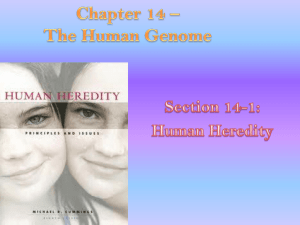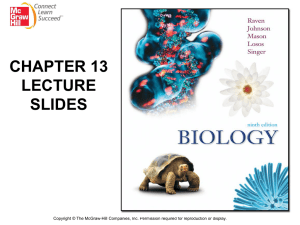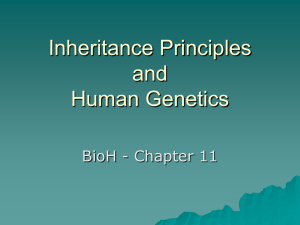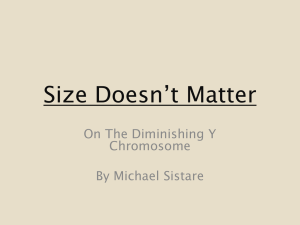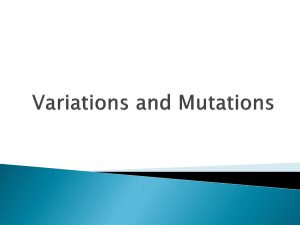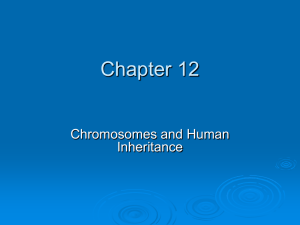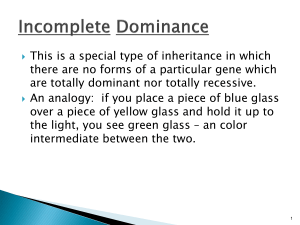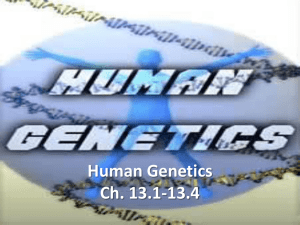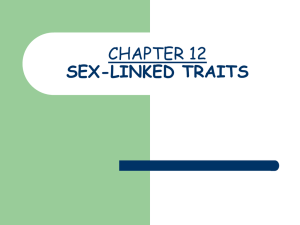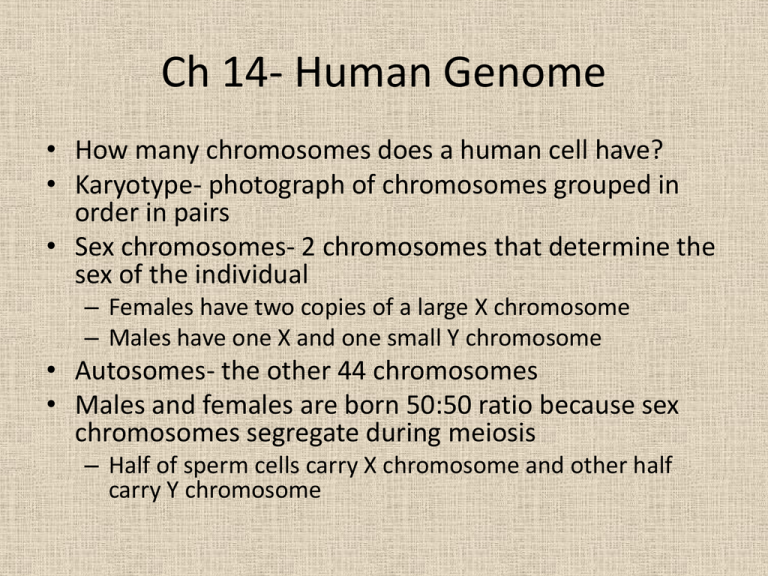
Ch 14- Human Genome
• How many chromosomes does a human cell have?
• Karyotype- photograph of chromosomes grouped in
order in pairs
• Sex chromosomes- 2 chromosomes that determine the
sex of the individual
– Females have two copies of a large X chromosome
– Males have one X and one small Y chromosome
• Autosomes- the other 44 chromosomes
• Males and females are born 50:50 ratio because sex
chromosomes segregate during meiosis
– Half of sperm cells carry X chromosome and other half
carry Y chromosome
Human Traits
• Biologists must identify if an inherited trait is
controlled by a single gene
• Pedigree- chart that shows the relationships
within a family that can be used to help identify
inherited traits
• Genetic counselors analyze pedigrees
• So can you look at a pedigree and figure out
which family the good looks came from?
– Shape of eyes and ears are actually polygenic traits
– Many traits influenced by environmental factors such
as nutrition and exercise
Human Genes
• Human genome- complete set of genetic
information- includes tens of thousands of genes
• DNA sequences on these genes carry information
for specifying many characteristics- eye color,
protein structure in cells
• Scientists spent years studying the genetics of our
species- able to identify genes that directly
control a single human trait
• Some of first genes identified were those that
control blood type
Blood Types
• Number of genes responsible for human blood groupsABO and Rh blood groups
• Rh blood group determined by a single gene with allelespositive and negative
– Positive allele is dominant
• ABO blood group has three alleles for this gene, I^A, I^B,
and I
–
–
–
–
A and B are codominant, blood type AB
I allele is recessive, I^AI^A and I^Ai is blood type A
I^BI^B and I^Bi is blood type B
People who are homozygous for I allele (ii) are blood type O
• Why is knowing the blood type important?
Autosomal Disorders in Humans
• Human genes have become known through study of
genetic disorders
• Phenylketonuria (PKU)- recessive allele, people lack the
enzyme that is needed to break down phenylalanine,
may build up in tissues during child’s first year and
cause mental retardation
• Tay- Sachs- recessive allele, lipid accumulation in brain
cells, blindness, death early in childhood
• Achondroplasia- dominant allele disorder, dwarfism
• Huntington’s disease- dominant allele, mental
deterioration and uncontrollable movements,
symptoms appear in middle age
• How do the actual DNA sequences in genes affect
phenotype so profoundly?
– Many genetic disorders are still being worked on, but
in both cystic fibrosis and sickle cell disease there is a
small change in the DNA of a single gene that affects
the structure of a protein, causing the disorder
• Cystic fibrosis- recessive allele disorder, excess
mucus in lungs, digestive tract, liver. More likely
to get infections
• Sickle cell disease- characterized by bent and
twisted shape of red blood cells, tend to get stuck
in capillaries and cause damage to cells, tissues,
organs
– Hemoglobin in person has different amino acid
sequence- just one DNA base is changed
– Common among African Americans
Sec 2- Human Chromosomes
• Chromosomes 21 and 22- smallest human autosomes
• First chromosomes whose sequences were determined
• Long stretches of repetitive DNA are unstable sites
where rearrangements occur
– Form of leukemia and neurofibromatosis found on
chromosome 22
– Gene associated with Lou Gehrig’s disease found on
chromosome 21
• Genes located together on same chromosome tend to
be inherited together
• Is there a special pattern of inheritance for genes
located on the X chromosome or the Y chromosome?
Sex Linked Genes
• Sex linked genes- gene located on the X or Y
chromosome
• Many sex linked genes found on X chromosome
• Y chromosome is much smaller than X, contains
only a few genes
• Colorblindness- an inability to distinguish certain
colors, most common is red-green, more
common in males
• Sex linked disorders are more common in men
– X-linked alleles are always expressed in males,
because males have only one X chromosome
• Hemophillia- another sex linked disorder, a protein
necessary for normal blood clotting is missing
• Duchenne Muscular Dystrophy- sex linked disorder, results
in progressive weakening and loss of skeletal muscle
• X-Chromosome Inactivation
– Females have 2 X chromosomes, one X chromosome is enough
• How does the cell “adjust” to the extra X chromosome in
female cells?
– In female cells, one X chromosome is randomly switched off-this
forms a Barr body
– Female cats
Chromosomal Disorders
• Nondisjunction- homologous chromosomes fail to separate during
meisois
– May involve autosomes, sex chromosomes, homologous
chromosomes
• If nondisjunction occurs, abnormal numbers of chromosomes may
find their way into gametes, and a disorder of chromosome
numbers may result
• Trisomy- when two copies of autosomal chromosomes fail to
separate during meiosis, individual is born with three copies of
chromosomes
• Down snydrome- most common form of trisomy, involves three
copies of chromosome 21
– Produces mild to severe mental retardation, and higher frequency of
some birth defects
Sex Chromosome Disorders
• Turner’s syndrome- females only inherit one X
chromosome
– Are sterile- unable to reproduce
– Sex organs do not develop at puberty
• Klinefelter’s syndrome- males inherit an extra X
chromosome
– Prevent individuals from reproducing
• No reported instances of babies born without an
X chromosome
– Contains genes vital for survival and development of
embryo
Sec 3- Human Molecular Genetics
• Roughly 6 billion base pairs in your DNA
• Genetic tests are now available for hundreds of
disorders
• DNA fingerprinting- form of DNA analysis that
analyzes sections of DNA that have little or no
known function that vary widely from individual
to individual
– Used to identify individuals
– Used since 1980’s in United States
• How has DNA fingerprinting been beneficial?
Human Genome Project
• Human Genome Project is the ongoing effort
in analyze the human DNA sequence
• Scientists have analyzed smaller genomes,
such as those of viruses and bacteria
• Why is this an important breakthrough?
– Provides useful clues to some of basic properties
of life
– May be useful in developing new drugs and
treatments for diseases
Gene Therapy
• The process of changing the gene that causes
a genetic disorder
• In gene therapy, an absent or faulty gene is
replaced by a normal, working gene
– Both positive and negative results
• What potential ethical problems might occur if
humans gain the opportunity to design our
bodies?
• High School Biology Resources

